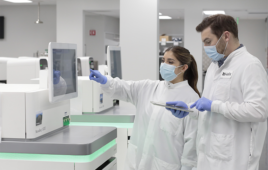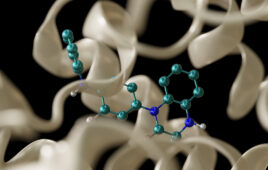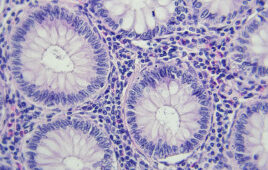Advances in reporter gene technology aid the investigation of cellular activity.
If you need to know what’s happening in an otherwise inaccessible place, send out a reporter. If it’s a mammalian cell, your options are many and growing by the day.
“People used to use reporters to look for very simplistic changes within a cell–influx of calcium, for example,” says Craig Monell, PhD, a scientific program director at Stratagene, an Agilent Technologies Company, La Jolla, Calif. “But now, reporters are getting far more specific. Assays allow you to identify which pathway is actually turned on.”
One such assay is PathDetect used with plasmids with enhancer elements specific to particular signaling pathways. Users can detect downstream activity of an individual transcription factor that, when promoter-bound, causes transcription of the reporter signal, be it green fluorescent protein (GFP) or luciferase.
The assay is specific, but only to a point. “Multiple transcription factors often act in concert to activate an endogenous promoter, but most of our vectors are not looking for multiple binding events,” Monell explains. Therefore, if the same transcription factor were turned on by several different pathways, PathDetect won’t discriminate between them in its report. For clarity, parallel assays can be performed.
A study using a PathDetect panel, highlighted at the 2006 American Society of Cell Biology meeting, addresses the recent interest in phosphorylation cascades. Monell presented results from his lab using HEK 293 cells, transfected with an MEKK transgene to elucidate the activation of the NFB pathway. “We knew that MEKK induced high NF?B signal when it was introduced. But then, if you add in PTPN5, a tyrosine phosphatase, it reduced the signal generated by the NF?B reporter.” The news was clear—PTPN5 inhibited the NF?B pathway as stimulated by MEKK.
Short Story: siRNA reporters
While phosphatase activity may be the flavor of the month, small interfering RNAs (siRNAs) are the hottest tools in town. Unfortunately, siRNA reagents require validation, which is laborious and time-consuming: Did the protein express? Do a Western Blot. “Westerns are quite cumbersome,” says George Tzertizinis, PhD, staff scientist, New England BioLabs, Ipswich, Mass. “You need to have antibodies and you are subject to protein degradation.” You also have to wash cells, lyse cells, make extract, and more. RT-PCR, though quantitative, is not much better.
“Our goal was to find a quick method to determine the efficacy of RNAi reagents,” Tzertizinis says. He proposed to use an RNAi reporter system anchored by a luciferase from the marine species, Gaussia princeps. “Gaussia has two key properties which are different from the most common luciferases. First, it’s secreted—and the secretion signal on the native protein functions [the same] in mammalian cells,” he explains. The advantage of this is that one can assay cells merely be assaying the medium. It also means that multiple time points can be assayed since the cells have remained intact.
Brain ways
“Tools are an especially limiting factor in neuroscience,” says Michael Lin, MD, PhD, postdoctoral fellow, University of California, San Diego. “Advances are defined by the available technology.” His particular concern is to try to investigate synaptic plasticity at the circuit level—to examine how circuits grow and reconfigure themselves during learning and memory fixation. “We needed to develop something that could see nascent changes in the synapse,” he says.
Existing reporters wouldn’t do. Older assays give only a general idea of translational activity and can’t provide the spatial resolution needed to examine the complex structure of a neuron. “We wanted to take it one step further and look at local synaptic modification,” says Lin. And that led to the development of TimeSTAMP (Time-Specific Tag for the Age Measurement of Proteins), a method to specifically label newly-synthesized copies of any protein with an epitope tag.
The key to visualizing synaptic modification is to look at the right molecules. Lin chose the Post-Synaptic Density protein (PSD-95). “PSD-95 is the most abundant structural element of the synapse, and previous work by others had shown that its accumulation correlates with synaptic growth,” Lin explains. So, having found a candidate reporter, he then linked it to an epitope tag. Lin’s next challenge was to avoid accumulation of the tag. The solution? To incorporate sequence for a protease, protease sites, and the tag, then fuse this module to the PSD-95 gene. Once transfected, cells translate the entire sequence but the tag is removed by the protease. Therefore, there is no protein signal until—this is the timing part—a protease inhibitor is added.
“You add this inhibitor and, from that point on, newly synthesized protease is prevented from working. That means, before inhibition everything is invisible because the tag is cleaved away,” Lin says. But, add the inhibitor and you get a signal.
Step away from the light
Fluorophores are terrific for cell culture or imaging ex vivo tissue, but for observations of a living animal (or person), innovation is needed. Enter the MRI-detected reporter construct. “MRI is based on magnetic fields,” explains Assaf Gilad, PhD, assistant professor of radiology, Johns Hopkins University, Baltimore, Md. Initial attempts to devise a reporter relied on metal. “If you express proteins that load iron (i.e., ferritin), these function like small magnets that will distort the magnetic field, appearing on your image as a black spot,” Gilad explains. This approach worked, but due to sites in the body where iron accumulates, the images proved too noisy.
“What we decided to do was create a reporter gene that is detectable, and that we can switch on and off,” he says. How does the switch work? It takes advantage of the exchange rate of protons between an expressed reporter protein and its aqueous environment—the protons of water. The exchange rate differs with the identity of the protein.
For Gilad’s construct, the optimal choice proved to be a peptide of polylysines. Once the construct has been introduced, “. . . what you do is irradiate at one frequency, transmit a radio wave, and you change the energetic level of these protons,” Gilad explains. And, if these protons are exchanged with water protons—those of a different energy level—that contrast can be imaged. If the switch is turned off, protons return to their relaxed energy state and the presence of the lysine-rich peptide is essentially inert within the cell until excited once again.
One proposed use of this new technique is the tracking of transplanted stem cells. In theory, the reporter could not only inform about the position of the cells, but also, depending on the construct, attest to the cell’s functionality.
About the Author
Neil Canavan is a freelance journalist of science and medicine based in New York.
This article was published in G & P magazine: Vol. 7, No. 11, November, 2007, pp. G6-G7.
Filed Under: Genomics/Proteomics



